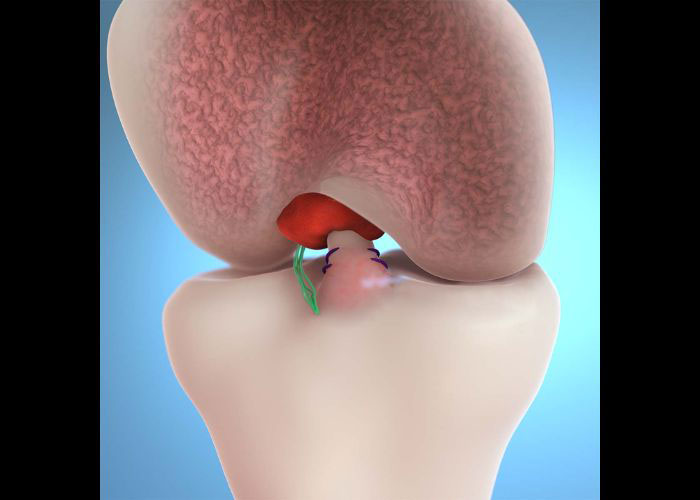What is knee malalignment?
The knee joint is an anatomically intricate joint involving the femur (thigh bone), tibia (shin bone), patella (kneecap), and surrounding soft-tissue structures. The complex arrangement of these structures enables the knee joint to sustain large amounts of internal and external stress every day. However, this weight-bearing responsibility of the knee joint is heavily reliant on a linear bone alignment for even weight distribution. If the femur or tibia cause a shift in the weight-bearing axis, a portion of the joint system will have to compensate often resulting in premature onset of osteoarthritis. Birth-related complications, the natural aging process, or a traumatic event can cause malalignment of the knee joint.
What is varus malignment?
A varus deformity occurs in a joint system where the bone furthest from the joint is angled towards the midline of the body and shifts the weight-bearing axis away from the center. In the knee joint, the inward angulation of the tibia causes the inner portion of the knee joint to bear more weight and frequently develops into a premature onset of osteoarthritis. Patients with varus malalignment tend to have a bowlegged appearance.
What is the treatment for knee malalignment?
Patients with minimal knee alignment without evidence of arthritic damage may respond well to non-operative treatment measures. These therapies may include avoiding high-impact activities that wear and tear on the knee joint and partaking in a strength training program to limit unnecessary pressure on the affected knee.
Yet, some patients may continue to experience persistent pain after a round of non-surgical treatments. These patients, in addition to those with an obvious bowlegged appearance, may require surgical intervention. The mechanical correction of knee alignment can be accomplished through a high tibial osteotomy surgical procedure. This procedure, also known as a proximal tibial osteotomy, aims to return the weight-bearing axis back to the center of the knee joint. Dr. Ronak Mukesh Patel, orthopedic knee doctor, treats patients in Sugar Land, Pearland, and the Houston, Texas area, who have experienced varus knee malalignment and are in need of a high tibial osteotomy.

What is a high tibial osteotomy procedure?
A high tibial osteotomy procedure can be performed by one of three surgical techniques. An opening wedge osteotomy creates a bone wedge along the inside portion of the tibia. A closing wedge osteotomy, the most common technique performed, removes a bone wedge from the lateral (outside) tibia which allows the knee joint to collapse onto the tibia. Lastly, a focal dome osteotomy creates a dome at the center of rotation to reduce bony end translation. Each of these techniques has a unique set of advantages, therefore Dr. Patel will evaluate the patient’s age, activity level, medical history, and desired outcomes to determine the appropriate surgical technique.
How is a closing wedge high tibial osteotomy performed?
A closing wedge high tibial osteotomy begins with Dr. Patel creating an incision along the anterior (front) knee joint. When the entire proximal tibia is visualized, guide wires are utilized to calculate the size of the bone wedge to be removed. An oscillating bone saw, in addition to other specialized surgical instruments, is introduced to cut along the guide wires and then remove the subsequent wedge-shaped bone fragment. The empty space that remains is closed and medical-grade plates and screws are fastened to the bone to secure the bony ends.
What is the recovery period like after a high tibial osteotomy?
The severity of malalignment prior to surgical repair often determines the recovery period following a high tibial osteotomy. The patient’s willingness to comply with post-operative instructions can also greatly impact the recovery process. Most patients can expect a full recovery with a return to normal daily activities 3-4 months with return to higher level activities thereafter depending on healing and recovery. Patients in Sugar Land, Pearland, and the Houston, Texas area can typically expect the following during recovery:
- Immediately following surgery, the repaired knee is placed into a locking knee brace for approximately 4-6 weeks to protect the osteotomy site while it heals.
- Weight-bearing will be considerably limited for the first 6-8 weeks after surgery due to the increased risk of a bone fracture from excessive weight. Any weight-bearing activity should be assisted with crutches.
- Weight-bearing progresses incrementally each week until 3 months. A new set of x-ray images are obtained to confirm appropriate correction and that the osteotomy site is completely healed.
- When the osteotomy site is completely healed, patients began working closely with a physical therapy team to wean off crutches and actively improve muscle strength and knee joint range of motion.
High Tibial Osteotomy Surgeon

If you have knee malalignment, especially a varus malalignment (bowlegged) you may benefit from a high tibial osteotomy. A high tibial osteotomy reshapes the bones of the knee to straighten the leg and prevent bowing as well as uneven wear and tear on the cartilage. High tibial osteotomy surgeon, Doctor Ronak Mukesh Patel, provides diagnosis as well as surgical and nonsurgical treatment options for patients in Houston, Sugar Land, and Pearland, TX who have been diagnosed with knee malalignment. Contact Dr. Patel’s team today!








